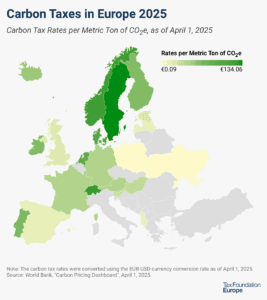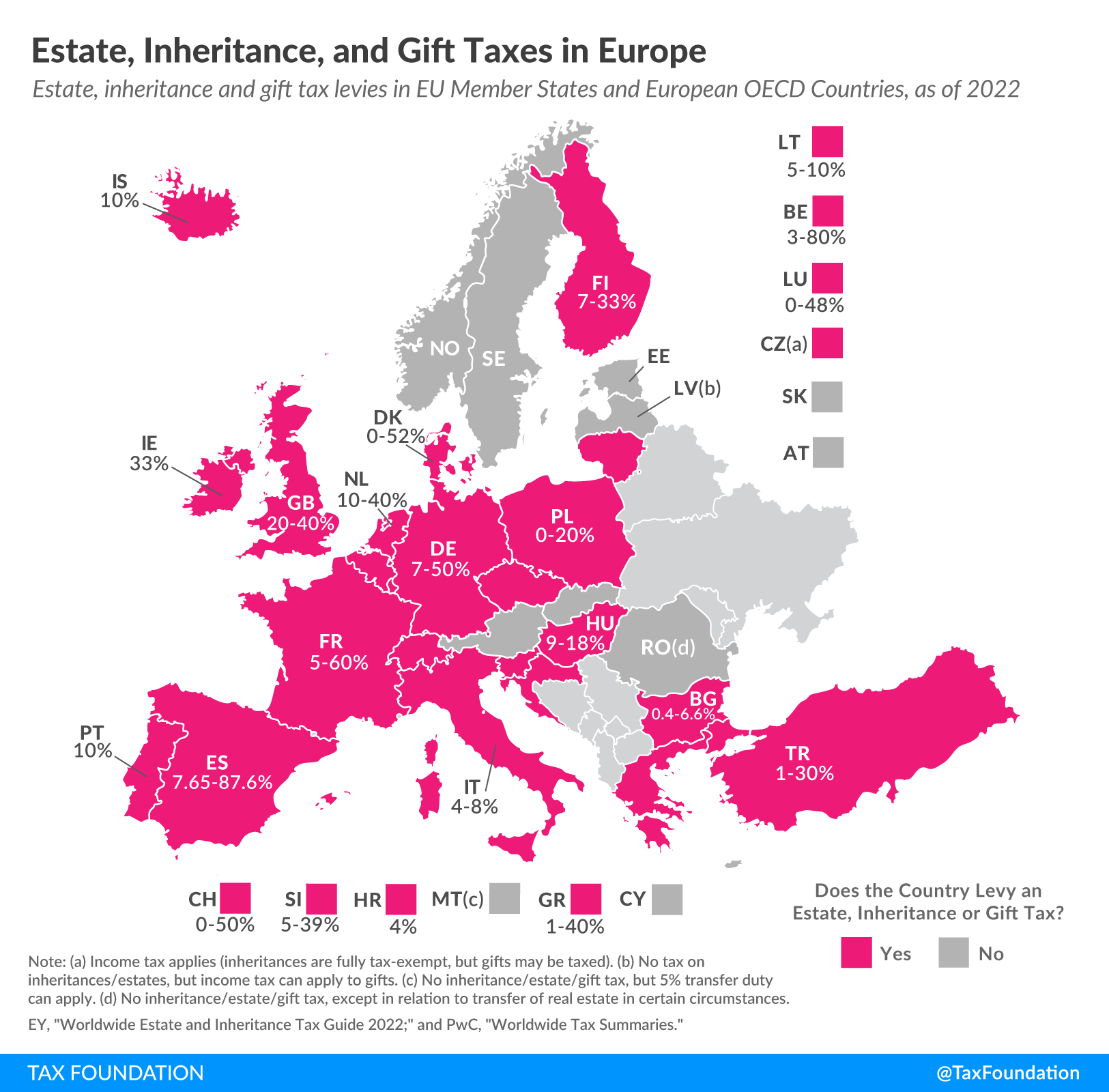
Estate, Inheritance, and Gift Taxes in Europe, 2023
3 min readBy:Inheritance taxes date back to the Roman Empire, which collected 5 percent of inherited property to pay soldiers’ pensions. Today, the practice is widespread.
The majority of European countries covered in today’s map currently levy estate, inheritance, or gift taxes. These countries are Belgium, Bulgaria, Croatia, the Czech Republic, Denmark, Finland, France, Germany, Greece, Hungary, Iceland, Ireland, Italy, Lithuania, Luxembourg, the Netherlands, Poland, Portugal, Slovenia, Spain, Switzerland, Turkey, and the United Kingdom.
Estate taxes are levied on the property of the deceased and paid by the estate itself. Inheritance taxes, in contrast, are only levied on the value of assets transferred and are paid by the heirs. Gift taxes are levied when property is transferred by a living individual.
Countries typically charge only estate or inheritance taxAn inheritance tax is levied upon the value of inherited assets received by a beneficiary after a decedent’s death. Not to be confused with estate taxes, which are paid by the decedent’s estate based on the size of the total estate before assets are distributed, inheritance taxes are paid by the recipient or heir based on the value of the bequest received. . However, estates can be double-taxed if they fall under two jurisdictions that apply different taxes. For this reason, European Union Member States have installed mechanisms intended to prevent or relieve double taxation if such a situation occurs.
As tempting as inheritance, estate, and gift taxes might look—especially when the OECD notes them as a way to reduce wealth inequality—their limited capacity to collect revenue and their negative impact on entrepreneurial activity, saving, and work should make policymakers consider their repeal instead of boosting them.
The taxA tax is a mandatory payment or charge collected by local, state, and national governments from individuals or businesses to cover the costs of general government services, goods, and activities. rates applied to estates, inheritances, and gifts often depend on the level of familial closeness to the inheritor as well as the amount inherited. For example, in France, different rates are applied to transfers to ascendants and descendants, transfers between siblings, blood relatives up to the fourth degree, and everyone else. For transfers to ascendants and descendants as well as between siblings, higher rates are applied to larger sums of money.
In some countries—such as Belgium, Spain, or Switzerland—estate, gift, and inheritance tax rates also vary by region. Most European countries do not tax transfers below a certain amount.
| Country | Estate /Inheritance/Gift Tax | Tax Rate |
|---|---|---|
| Austria (AT) | No | – |
| Belgium (BE) | Yes | 3-80% (depends on region) |
| Bulgaria (BG) | Yes | 0.4-6.6% |
| Croatia (HR) | Yes | 4% |
| Cyprus (CY) | No | – |
| Czech Republic (CZ) | Yes | Income tax applies (inheritances are fully tax-exempt, but gifts may be taxed) |
| Denmark (DK) | Yes | 0-52% |
| Estonia (EE) | No | – |
| Finland (FI) | Yes | 7-33% |
| France (FR) | Yes | 5-60% |
| Germany (DE) | Yes | 7-50% |
| Greece (GR) | Yes | 1-40% |
| Hungary (HU) | Yes | 9-18% |
| Iceland (IS) | Yes | 10% |
| Ireland (IE) | Yes | 33% |
| Italy (IT) | Yes | 4-8% |
| Latvia (LV) | No | No tax on inheritances/estates, but income tax can apply to gifts |
| Lithuania (LT) | Yes | 5-10% |
| Luxembourg (LU) | Yes | 0-48% |
| Malta (MT) | No | No inheritance/estate/gift tax, but 5% transfer duty can apply |
| Netherlands (NL) | Yes | 10-40% |
| Norway (NO) | No | – |
| Poland (PL) | Yes | 0-20% |
| Portugal (PT) | Yes | 10% |
| Romania (RO) | No | No inheritance/estate/gift tax, except in relation to transfer of real estate in certain circumstances |
| Slovakia (SK) | No | – |
| Slovenia (SI) | Yes | 5-39% |
| Spain (ES) | Yes | 7.65-87.6% (depends on region) |
| Sweden (SE) | No | – |
| Switzerland (CH) | Yes | 0-50% (depends on canton) |
| Turkey (TR) | Yes | 1-30% |
| United Kingdom (GB) | Yes | 20-40% |
|
Sources: EY, “Worldwide Estate and Inheritance Tax Guide 2022,” July 22, 2022, https://assets.ey.com/content/dam/ey-sites/ey-com/en_gl/topics/tax/tax-pdfs/ey-final-worldwide-estate-and-inheritance-tax-guide-2022.pdf; and PwC, “Worldwide Tax Summaries,” accessed April 20, 2023, https://taxsummaries.pwc.com/. |
||






